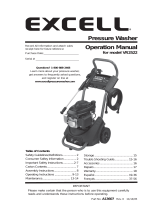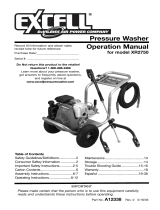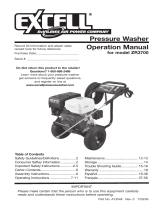
Copyright © 2018 MAT Industries, LLC
3 - ENG
IMPORTANT SAFETY INSTRUCTIONS (CONT.)
• SAVE ALL INSTRUCTIONS
WHAT CAN HAPPEN HOW TO PREVENT IT
• Your pressure washer operates at uid pressures
and velocities high enough to penetrate human and
animal esh, which could result in amputation or other
serious injury. Leaks caused by loose ttings or worn
or damaged hoses can result in injection injuries.
DO NOT TREAT FLUID INJECTION AS A SIMPLE CUT!
See a physician immediately!
• Inspect the high-pressure hose regularly. Replace the
hose regularly. Replace the hose immediately if it is
damaged, worn, has melted from contacting the engine,
or shows any signs of cracking, bubbles, pinholes, or
other leakage. Never grasp a high-pressure hose that is
leaking or damaged.
• Never touch, grasp or attempt to cover a pinhole or
similar water leak on the high-pressure hose. The stream
of water IS under high pressure and WILL penetrate skin.
• Never place hands in front of nozzle.
• Direct spray away from self and others.
• Make sure hose and ttings are tightened and in good
condition. Never hold onto the hose or ttings during
operation.
• Do not allow hose to contact mufer.
• Never attach or remove wand or hose ttings while
system is pressurized.
• Injuries can result if system pressure is not reduced
before attempting maintenance or disassembly.
• To relieve system pressure, shut off engine, turn off water
supply and pull gun trigger until water stops owing.
• Use only hoses and accessories rated for pressure
higher than your pressure washer’s PSI.
DANGER
RISK OF FLUID INJECTION AND LACERATION
WHAT CAN HAPPEN HOW TO PREVENT IT
• Spilled gasoline and its vapors can become ignited from
cigarette sparks, electrical arcing, exhaust gases and hot
engine components such as the mufer.
• Shut off engine and allow it to cool before adding fuel to
the tank.
• Use care in lling tank to avoid spilling fuel. Move
pressure washer away from fueling area before starting
engine.
• Heat will expand fuel in the tank, which could result in
spillage and possible re explosion.
• Fill tank to ½˝ (12.7 mm) below bottom of ller neck to
provide space for fuel expansion.
• Operating the pressure washer in an explosive
environment could result in a re.
• Operate and fuel equipment in well-ventilated areas
free from obstructions. Equip areas with re extinguisher
suitable for gasoline res.
• Materials placed against or near the pressure washer
can interfere with its proper ventilation features causing
overheating and possible ignition of the materials.
• Never operate pressure washer in an area containing dry
brush or weeds.
• Mufer exhaust heat can damage painted surfaces, melt
any material sensitive to heat (such as siding, plastic,
rubber, vinyl, or the pressure hose, itself), and damage
live plants.
• Always keep pressure washer a minimum of 4´ (1.2m)
away from surfaces (such as houses, automobiles or
live plants) that could be damaged from mufer exhaust
heat.
• Improperly stored fuel could lead to accidental ignition.
Fuel improperly secured could get into the hands of
children or other unqualied persons.
• Store fuel in an OSHA-approved container, in a secure
location away from work area.
• Use of acids, toxic or corrosive chemicals, poisons,
insecticides, or any kind of ammable solvent with this
product could result in serious injury or death.
• Do not spray ammable liquids.
DANGER
RISK OF EXPLOSION FOR FIRE



























